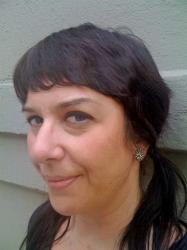A brush with the London art world
The work of Anita Allyn, chair of the art department, was exhibited in London’s Tate Modern art museum as part of the museum’s 10th anniversary festival, “No Soul for Sale.”


Somewhere inside London’s Tate Modern art museum, a seven-foot pop-culture meteorite has landed. Look closely at the bulky mass, and you’ll see some familiar faces—Ronald Reagan, Oprah, Bill Clinton, Martha Stewart—along with images of a pink stretch hummer, a blue monster truck, and other American mainstays. And there, high above the rest, is Anita Allyn’s contribution: a protest poster made from historical photographs collaged onto an old Star Wars poster.
While the installation wasn’t the first time Allyn (the chair of TCNJ’s art department) has exhibited her work abroad, it had a special significance: she helped assemble the piece on-site this past May along with other members of Vox Populi—the Philadelphia artist’s collective of which she’s a member. The group was invited along with more than 70 others to celebrate the Tate’s 10th anniversary with a festival titled “No Soul for Sale.”
“Our [meteorite] work ended up being a lot of popular culture images and initially, I thought the work was very much about an American identity,” Allyn recalls. “But it turned out the [non-American] viewers and other artists who were there felt it was as much their identity as it was American identity. The whole idea of us exporting movie stars and superstars and the idea that popular culture is really propagated by America became evident.”
Allyn has been passionate about art for as long as she can remember. “I don’t remember going through the phases of, ‘I’m going to be a firefighter,’ or ‘I’m going to be a doctor,’” she says. “Teaching and art-making was always it for me.” She took art classes throughout high school, and earned a BFA from The Kansas City Art Institute and an MFA from The School of the Museum of Fine Arts at Tufts University. A few years later, she landed at TCNJ, where she’s been ever since—teaching classes and making art.
“I feel very compelled by photographic mediums, and I’m also excited about using found imagery,” she says. “My works often combine photography, video, animation and print, and I’m very much about repetition in process. I’m dedicated to a certain kind of aesthetic practice that’s usually very time consuming and very elaborate, even though it might not look like it.”
Consider the series of photographs she created about five years ago. Looking to question her rationale for having, collecting, and keeping so much “stuff,” Allyn photographed everything she owned—clothing, food, furniture, knick-knacks—and then removed the backgrounds via Photoshop and classified the objects by color. She showed the 350 images together at a gallery in Philadelphia and wound up selling the whole show to one person. “It was the first time that had ever happened to me,” she says, “and it was very exciting.”

While such works are certainly time consuming and intensive to create, Allyn suspects it’s something else about her work that first grabs a viewer’s attention. “I think it has to do with working with images that are familiar,” she says. “For example, in this cataloguing piece, people would say, ‘Oh, I have that,’ or, ‘Oh, I collect that.’ So I think in much of my work there’s some element of familiarity, but hopefully also something that surprises and engages people, too.”
Though certain industries are currently in shambles, Allyn insists that there is no better time to be a visual creator/interpreter. “With the constant media and multi-tasking with those media, I think we’ve become much more visual than we were 25 years ago—and much more so than 50 years ago—in terms of our ability to read visual images more clearly. It’s a really exciting and compelling time to be making work.”
In life post-Tate, Allyn is continuing to add her own contributions to what she describes as “all the visual stimuli around us.” She’s been working on a video animation that explores the history of war, and is starting to plan for her 2011 show at Vox Populi’s gallery in Philadelphia. “I’ve been thinking about political posters from previous generations and reframing and re-visualizing those,” she says. Like she did with her protest-style poster at the Tate, “I’m pointing to the question of whether those [posters] are relevant any longer, or if they just become beautiful images.”
Posted on August 19, 2010

